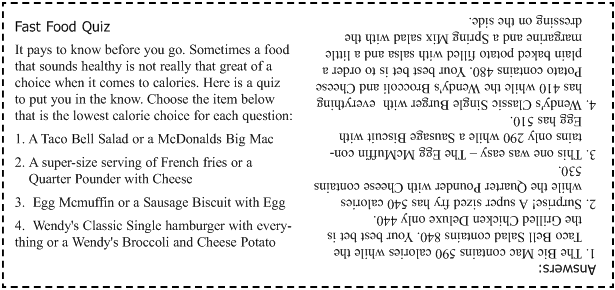Fast Food Facts
At some time during a typical week, you are super hungry and in a big hurry; furthermore, you are not in a position to prepare your own meal. If you are in your car you might be tempted to stop at a fast food restaurant. You are not alone! Sales for quick-service restaurant operators are projected to increase 4.8 percent in 2003, to $137.8 billion, according to the National Restaurant Association’s publication, Restaurant Industry Forecast – 2003. (FMI?see www.restaurant.org)This page will help you make a better choice the next time you enter a fast food restaurant. Here are some facts to consider from Marylou Anderson, RD, nutritionist at a community health center in Seattle:• A supersized soft drink (42 oz) contains 136 grams of sugar which is equal to 34 teaspoons of sugar.• A Kentucky Fried Chicken Original Recipe Two Piece Meal (mashed potatoes and gravy, cole slaw, and biscuit) contains 2446 milligrams of sodium equal to about the amount of sodium we should not exceed in one day. (This amount would actually be less if you already have high blood pressure.)• A Burger King Fish Fillet Sandwich and medium serving of French fries contains 5-1/2 tablespoons of fat (61 grams).Marylou offers 4 easy ways to lower the amount of fat, sodium and calories you consume in a fast food meal:1. Choose baked, grilled or broiled items instead of fried. Salads, grilled chicken, baked potatoes and small lowfat sandwiches are always your best choices.2. Put condiments on the side.3. Order diet soda, unsweetened tea or water instead of soda or other sweetened beverages.4. Don’t supersize your meals. Fast food nutrition information can be found at the restaurants' individual website or an interactive fast food website at http://www.olen.com/food/.
Fast food nutrition information can be found at the restaurants' individual website or an interactive fast food website at http://www.olen.com/food/.
